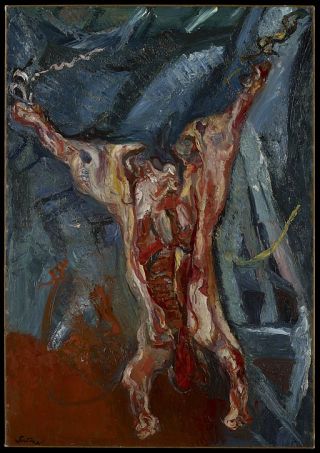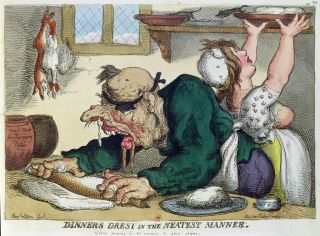Emotions
Disgust: An Emotion Most Vile
Exploring our visceral reactions of revulsion.
Updated January 8, 2024 Reviewed by Devon Frye
Key points
- Darwin was the first to recognize disgust as an emotion that can involve all senses, but especially taste.
- Researchers believe it evolved to protect humans from exposure to pathogens, but now has a moral component.
- Disgust focuses on the body, but flowers in our imagination.
- When it has a moral component, it is closely aligned with disdain, contempt, and stigmatization.

“There was never the least attention paid to what was cut up for sausage… there would be meat that had tumbled out on the floor, in the dirt and sawdust, where the workers had spit uncounted billions of consumption germs… there would be meat stored in great piles in rooms… and thousands of rats would race about it… the packers would put poison bread out for them; they would die, and then rats, bread, and meat would go into the hoppers together… these were the things that went into the sausage” (Sinclair, The Jungle, 1906).
Upton Sinclair’s classic description of early 20th-century meat packing is disgusting, to be sure. But disgust's "most troubling," and perhaps its most fascinating, aspect: “It attracts as well as repels” (W.I. Miller, 1997), a fact emphasized by Freud (1905). Disgust is an emotion of "considerable contradiction" (Strohminger, 2014).
The concept of disgust was pervasive in classical Latin and Greek literature (Lateiner and Spatharas, 2017), though the word itself did not appear until the 16th century.
Shakespeare never used the actual word. Nevertheless, his plays are replete with vile, foul, repulsive images, including one of Antony “quenching his thirst with horse urine”(Antony and Cleopatra), detailed in the newly published book Shakespeare and Disgust (Irish, 2023).

Darwin (1890) was the first to recognize disgust as an emotion. “Disgust is a sensation… (that) refers to something revolting, primarily in relation to the sense of taste,” but any of the senses can potentially create a similar feeling. Darwin wrote of the characteristic facial expression, including “extreme disgust,” with an open mouth about to vomit.
Disgust was initially considered a "motivational system" that evolved to detect pathogens (Kavaliers et al, 2018). It was an "emotion of regulation" governing incorporation and expulsion (Irish).
Paul Rozin, a research pioneer on disgust, writes that we do not know how or when disgust originated. There are several theoretical perspectives, other than an evolutionary one that emphasizes pathogens and contamination, including a cognitive neuroscience approach, with a focus on brain regions, such as the insula (Kavaliers et al, 2021), and a psychopathology perspective, with its focus on fear and anxiety (Rozin et al, 2018).
Other researchers have suggested that disgust may have evolved not only to avoid pathogen contamination but to regulate decisions about a choice of mate and morality (i.e., creating sexual disgust) (Tybur et al, 2013).
.jpg?itok=T6NXA2vC)
Disgust has been described as a “shape-shifter.” With repeated contact, the same object can lose its capacity to stimulate disgust. Many occupations, such as physicians, plumbers, and soldiers, must overcome and cope with any initial disgust they may feel to perform their work effectively (Wilson, 2002).
One study, though, found that disgust is a "common experience" among healthcare professionals, though rarely discussed, and may lead to the neglect and abuse of patients (Hadjittofi et al, 2020).
The intensity of disgust increases the closer we are to the offending products, including human or animal waste, such as feces, urine, saliva, and sweat (Angyal, 1941). "Biologists have thought that dirt, in the form of bodily excretions, produces a universal feeling of disgust. They should remember that there is no such thing as dirt... dirt is essentially disorder... dirt is matter out of place" (Douglas, 1966).
Human tears, though, do not elicit disgust (Rozin et al). Tears are the "stuff of romantic poetry: they do not defile... they purify, cleanse, bathe the eyes." Most importantly, they are unrelated to digestion or procreation (Douglas).
Feces seem to be an almost universal trigger for disgust, though there are differences among cultures (Rozin et al). "Disgust... especially in other people's feces... likely relates to the high degree of interest in what is so odorous, organic, and recently contained within the body," (S.B. Miller, 2004), consistent with Freud's concept of reaction formation.
Infants do not register actual disgust or react to aversive odors, although they can demonstrate a dislike for bitterness. A full-blown disgust reaction requires “enculturation,” i.e., social learning and increased cognitive functioning, usually after toilet training, from ages 3 to 5 (Rozin et al).

In his novel Amsterdam, McEwan writes of his protagonist’s disgust at finding a mass of chewing gum embedded in his shoe, “Beneath the patina of grime, the gum was still slightly pink, like flesh, and the smell of peppermint was faint but distinct. How appalling, the intimate contact with the contents of a stranger’s mouth” (1999).
The reasons for such strong negative reactions are not always obvious (Angyal). Disgust is “far from simple, (and) never a self-evident affect… the imagination itself underlies all experiences of disgust.” Disgust “centers upon the body, but flowers in the imagination” (Wilson).
Disgust is “invariably a matter of boundaries”: many things seem disgusting only because they threaten or transgress our personal space (Wilson). In that sense, disgust is a gatekeeper emotion (S.B. Miller).

The “'sympathetic law of contagion' seems to be operative: once in contact, always in contact” (Rozin and Fallon, 1987). Prototypically, write Rozin and colleagues, the odor of disgust is the odor of decay.
Notions of disgust, though, can change with intimacy or love (W.I. Miller). For example, Freud says, “A man who will kiss a pretty girl’s lips passionately may perhaps be disgusted at the idea of using her toothbrush” (1905).
Several self-report scales are used to measure disgust, but studies have used different scales and reflect considerable variability in theory, measurement, and even culture (Rozin et al; Davey, 2011).
Disgust has evolved from matters of taste to a moral term closely associated with disdain and contempt (Wilson). Described as moral dyspepsia, disgust is a "messy emotion" (Irish). “How can one emotion—disgust—have elicitors as diverse as excrement, amputation, incest, and flag burning?” (Rozin and Haidt, 2013).

Though that question remains, we know that disgust became a “regulating affect” that societies use to control by stigmatizing and marginalizing individuals for their appearance or behavior (Wilson). Those who are excessively obese, for example, are often victims of stigma and may elicit disgust in others who wish to create social distance from them (Vartanian et al, 2016; Vartanian et al, 2018).
Disgust is an emotion that imagines other people as less than human (Lateiner and Spatharas). The Nazis, for example, referred to Jews as vermin, and the Hutu, during the Rwandan genocide, described the Tutsi as cockroaches (Rozin et al).

By encouraging stigmatization, disgust can lead to avoidance, social withdrawal, and even aggression, particularly when it generates fears of contamination, shame, and even self-disgust (Terrizzi et al, 2023).
References
Angyal A. (1941). Disgust and related aversions. The Journal of Abnormal and Social Psychology: 393-412.
Darwin C. (1872/2009). The Expression of the Emotions in Man and Animals. Edited by Joe Cain and Sharon Messenger. London: Penguin Books.
Davey GCL. (2011). Disgust: the disease-avoidance emotion and its dysfunctions. Philosophical Transactions of the Royal Society 366: 3453-3465.
Douglas M. (1966/2002). Purity and Danger. New York: Routledge Classics.
Freud S. (1905/1968). Three Essays on Sexuality, Volume VII. In: The Standard Edition of Sigmund Freud. Edited by James Strachey. London: The Hogarth Press, pp. 123-245.
Hadjittofi M; Gleeson K; Arber A. (2020). The experience of disgust by healthcare professionals: a literature review. International Journal of Nursing Studies 110: 103720. (14 pages.)
Irish BK. (2023). Shakespeare & Disgust: The History and Science of Early Modern Revulsion. London: The Arden Shakespeare. (Kindle edition)
Kavaliers M; Ossenkopp K-P; Choleris E. (2018). Social neuroscience of disgust. Genes, Brain and Behavior 18:e12508 (13 pages)
Kavaliers M et al (2021). Social factors and the neurobiology of pathogen avoidance. Biology Letters 18: 20210371. (11 pages)
Lateiner D; Spatharas D. (2017). Introduction: Ancient and Modern Modes of Understanding and Manipulating Disgust. In: The Ancient Emotion of Disgust. Edited by Donald Lateiner & Dimos Spatharas. New York: Oxford University Press, pp. 1-42.
McEwan I. (1999). Amsterdam. New York: Anchor Books, A Division of Random House, Inc.
Miller SB. (2004). Disgust: The Gatekeeper Emotion. Hillsdale, NJ: The Analytic Press.
Miller WI. (1997). The Anatomy of Disgust. Cambridge, MA: Harvard University Press.
Rozin P; Haidt J. (2013). The domains of disgust and their origins: contrasting biological and cultural evolutionary accounts. Trends in Cognitive Sciences 17(8): 367-368.
Rozin P; Fallon AE. (1987). A perspective on disgust. Psychological Review 94(1): 23-41.
Rozin P; Haidt J; McCauley C. (2018). Disgust (Chapter 46). In: Handbook of Emotions, Fourth Edition. Edited by Lisa Feldman Barrett; Michael Lewis; Jeannette M. Haviland-Jones, New York: The Guilford Press, pp. 815-834.
Sinclair U. (1906/2019). The Jungle. Middletown, Delaware: SDE Classics, pp. 139-141.
Strohminger N. (2014). Disgust talked about. Philosophy Compass 9/7: 478-493.
Terrizzi JA, Jr. et al (2023). How does disgust regulate social rejection? A mini-review. Frontiers in Psychology 14:1141100 (6 pages)
Tybur J. et al (2013). Disgust: evolved function and structure. Psychological Review 120(1): 65-84.
Vartanian LR; Trewartha T; Vanman EJ. (2016). Disgust predicts prejudice and discrimination toward individuals with obesity. Journal of Applied Social Psychology 46: 369-375.
Vartanian LR et al (2018). Physiological and self-reported disgust reactions to obesity. Cognition and Emotion 32(3): 579-592.
Wilson RR. (2002). The Hydra’s Tale: Imagining Disgust. Edmonton, Alberta. University of Alberta Press.




